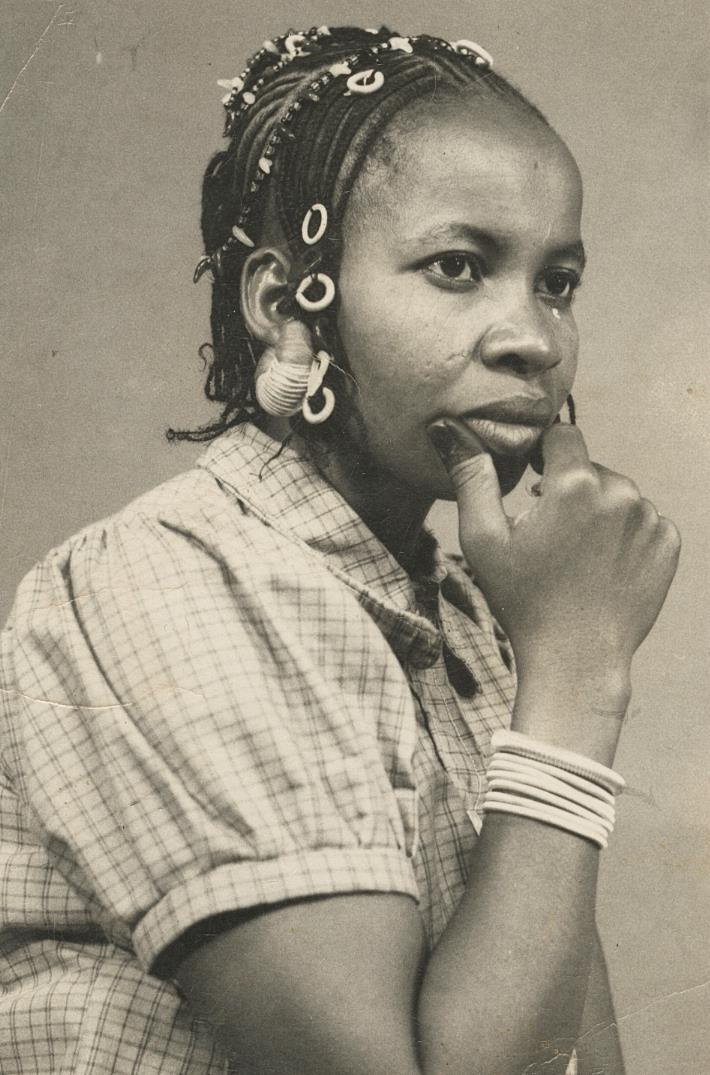When you click on links to various merchants on this site and make a purchase, this can result in this site earning a commission. Affiliate programs and affiliations include, but are not limited to, the eBay Partner Network.
a.imagelink {color:#0000FF;} a:hover.imagelink {color:#0000FF;} a:visited.imagelink {color:#800080;} a.imagelink img.saleimage { border: 2px solid #0000FF; } a:visited.imagelink img.saleimage { border: 2px solid #800080; } This is a c. 1970\'s silver gelatin photograph by Malick Sidibe (bio below). Measures 3.375\" x 5\". Surface damage and soiling. Creasing throughout. See photos for condition.
Yes, I do combine shipping. Additional shipping per item is 20% of the lower shipping cost [For example, if 2 items are purchased that have a $30 and $10 shipping cost each, the combined shipping cost becomes $32 for the 2 items]. If offerding/buying more than 1 item, please wait for an invoice with combined shipping before paying. Shipping cost is non-negotiable, please consider it when offerding/buying. I ship within 1 business day. Please make payment within 4 days of purchase.
** In no manner am I representing the sale of a digital image of the item or selling the rights to the image (copyright) to the buyer. The sale is for the physical object only and is original, not being newly reproduced. **
_________________________
Malick Sidibé (1935 – 14 April 2016) was a Malian photographer noted for his black-and-white studies of popular culture in the 1960s in Bamako. Sidibé had a long and fruitful career as a photographer in Bamako, Mali, and was a well-known figure in his community. In 1994 he had his first exhibition outside of Mali and received much critical praise for his carefully composed portraits. Sidibé\'s work has since become well known and renowned on a global scale. His work was the subject of a number of publications and exhibited throughout Europe and the United States. In 2007, he received a Golden Lion Award for Lifetime Achievement at the Venice Biennale, becoming both the first photographer and the first African so recognized. Other awards he has received include a Hasselblad Award for photography, an International Center of Photography Infinity Award for Lifetime Achievement, and a World Press Photo award.
Sidibé\'s work is held in the collections of The Contemporary African Art Collection (CAAC), the J. Paul Getty Museum in Los Angeles, and the Museum of Modern Art in New York.
Life and work
Sidibé was born in the village of Soloba, 300 km from Bamako, in Mali. His father, a stock breeder, farmer, and skilled hunter named Kolo Barry Sidibé. Malick\'s father had wanted him to attend school, but passed before he was able to attend at the age of 16. In 1955 photographer Gérard Guillat came to the school looking for a student to decorate his studio, eventually hiring Sidibé. Guillat was impressed with his work and took him on as an apprentice. Sidibé\'s first tasks included calibrating equipment, and delivering prints. He soon learned more about photography as he assisted Guillat, and eventually took on his own clients. In 1957 Guillat closed his studio, and Sidibé began taking photographs of Bamako nightlife. He specialized in documentary photography, focusing particularly on the youth culture of the Malian capital. Sidibé took photographs at sport events, the beach, nightclubs, concerts, and even tagged along while the young men seduced girls. He increasingly became noted for his black-and-white studies of popular culture in the 1960s in Bamako. In the 1970s, Sidibé turned towards the making of studio portraits. His background in drawing became useful:
As a rule, when I was working in the studio, I did a lot of the positioning. As I have a background in drawing, I was able to set up certain positions in my portraits. I didn\'t want my subjects to look like mummies. I would give them positions that brought something alive in them.
In 1962 Sidibé opened his own studio in the Bagadadji neighborhood or Bamako. Sidibé continued to take photos of the surprise parties and club gatherings of the city until 1976. He attributed ending his career in reportagé to fewer club parties, rise in availability of affordable cameras, and the growth of the auto-lab film development industry. Sidibé continued to shoot black and white studio portraits, ID photos, and fix broken cameras at his Bamako studio. While Sidibé was locally famous for decades, he was not introduced into the Western fine art world until 1994 when he had a chance encounter with French curator André Magnin. One of the best known of Sidibé\'s works from that time is Nuit de Noel, Happy Club (Christmas Eve, Happy Club) (1963), depicting a smiling couple — the man in a suit, the woman in a Western party dress (but barefoot) and both dancing, presumably, to music. And it was images like these that revealed how Sidibé\'s photographic style was inextricably linked to music. This connection is something that Sidibé had spoken about during interviews, over the years.
\"We were entering a new era, and people wanted to dance. Music freed us. Suddenly, young men could get close to young women, hold them in their hands. Before, it was not allowed. And everyone wanted to be photographed dancing up close.\"
It is perhaps no surprise that other Malian artists, such as the musicians Salif Keita and Ali Farka Touré, also came to international attention in the 1990s at almost the same moment as Malian photography was being recognized.
Sidibé used flash when out in the field, but only tungsten lighting in the studio. He used an Agfa 6 x 6 camera with bellows to shoot weddings and more formal events, and a Foca Sport 24 x 36 for his more candid work. He was known as a very charming person and would tell his clients jokes to put them at ease while shooting portraits. The Grammy award-winning video of Janet Jackson\'s 1997 song \"Got \'til It\'s Gone\" is strongly indebted to the photographic style of Sidibé, and the video pays tribute to a particular time (during the 1960s and \'70s) that Sidibé\'s pictures had helped to document. This was the time period just after the French Sudan (and then the Mali Federation) had gained their Independence from France in 1960. This new era (post-1960) has, subsequently, been characterized by various observers as a post-colonial (and post-apartheid) awakening of consciousness. Many of those who admire Sidibé\'s work believe that he somehow captured the joy and wonder of this awakening, and that it is seen in the faces, scenes, and images that he helped to illuminate. More recently, Sidibé\'s influence can be seen directly through Inna Modja’s 2015 video for her song \"Tombouctou,\" as it was filmed in Sidibé\'s photography studio.
In 2006, Tigerlily Films made a documentary entitled Dolce Vita Africana about Sidibé, filming him at work in his studio in Bamako, having a reunion with many of his friends (and former photographic subjects) from his younger days, and speaking to him about his work.
Sidibé became the first African and the first photographer to be awarded the Golden Lion Award for Lifetime Achievement at the Venice Biennale in 2007. Robert Storr, the show\'s artistic director, said:
No African artist has done more to enhance photography\'s stature in the region, contribute to its history, enrich its image archive or increase our awareness of the textures and transformations of African culture in the second half of the 20th century and the beginning of the 21st than Malick Sidibé.
Sidibé died of complications from diabetes in Bamako. He was survived by 17 children and three wives.Pictures sell!
Auctiva offers Free Image Hosting and Editing.
The complete Selling Solution.










